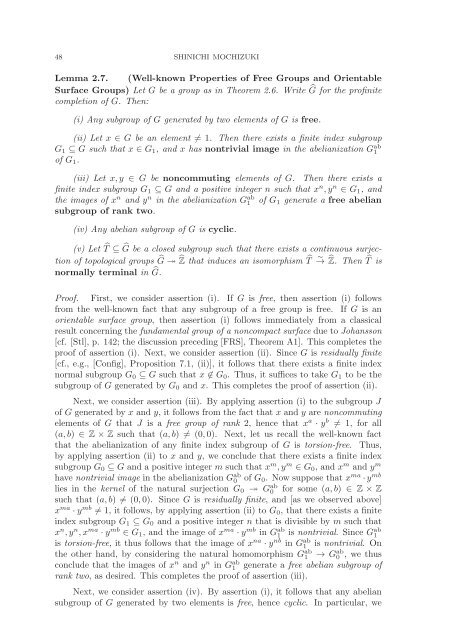Inter-universal Teichmuller Theory I: Construction of Hodge Theaters
Inter-universal Teichmuller Theory I: Construction of Hodge Theaters
Inter-universal Teichmuller Theory I: Construction of Hodge Theaters
You also want an ePaper? Increase the reach of your titles
YUMPU automatically turns print PDFs into web optimized ePapers that Google loves.
48 SHINICHI MOCHIZUKI<br />
Lemma 2.7. (Well-known Properties <strong>of</strong> Free Groups and Orientable<br />
Surface Groups) Let G be a group as in Theorem 2.6. Write Ĝ for the pr<strong>of</strong>inite<br />
completion <strong>of</strong> G. Then:<br />
(i) Any subgroup <strong>of</strong> G generated by two elements <strong>of</strong> G is free.<br />
(ii) Let x ∈ G be an element ≠1. Then there exists a finite index subgroup<br />
G 1 ⊆ G such that x ∈ G 1 ,andx has nontrivial image in the abelianization G ab<br />
1<br />
<strong>of</strong> G 1 .<br />
(iii) Let x, y ∈ G be noncommuting elements <strong>of</strong> G. Then there exists a<br />
finite index subgroup G 1 ⊆ G and a positive integer n such that x n ,y n ∈ G 1 ,and<br />
the images <strong>of</strong> x n and y n in the abelianization G ab<br />
1 <strong>of</strong> G 1 generate a free abelian<br />
subgroup <strong>of</strong> rank two.<br />
(iv) Any abelian subgroup <strong>of</strong> G is cyclic.<br />
(v) Let ̂T ⊆ Ĝ be a closed subgroup such that there exists a continuous surjection<br />
<strong>of</strong> topological groups Ĝ ↠ Ẑ that induces an isomorphism ̂T → ∼ Ẑ. Then̂T is<br />
normally terminal in Ĝ.<br />
Pro<strong>of</strong>. First, we consider assertion (i). If G is free, then assertion (i) follows<br />
from the well-known fact that any subgroup <strong>of</strong> a free group is free. If G is an<br />
orientable surface group, then assertion (i) follows immediately from a classical<br />
result concerning the fundamental group <strong>of</strong> a noncompact surface due to Johansson<br />
[cf. [Stl], p. 142; the discussion preceding [FRS], Theorem A1]. This completes the<br />
pro<strong>of</strong> <strong>of</strong> assertion (i). Next, we consider assertion (ii). Since G is residually finite<br />
[cf., e.g., [Config], Proposition 7.1, (ii)], it follows that there exists a finite index<br />
normal subgroup G 0 ⊆ G such that x ∉ G 0 . Thus, it suffices to take G 1 to be the<br />
subgroup <strong>of</strong> G generated by G 0 and x. This completes the pro<strong>of</strong> <strong>of</strong> assertion (ii).<br />
Next, we consider assertion (iii). By applying assertion (i) to the subgroup J<br />
<strong>of</strong> G generated by x and y, it follows from the fact that x and y are noncommuting<br />
elements <strong>of</strong> G that J is a free group <strong>of</strong> rank 2, hence that x a · y b ≠ 1, for all<br />
(a, b) ∈ Z × Z such that (a, b) ≠(0, 0). Next, let us recall the well-known fact<br />
that the abelianization <strong>of</strong> any finite index subgroup <strong>of</strong> G is torsion-free. Thus,<br />
by applying assertion (ii) to x and y, we conclude that there exists a finite index<br />
subgroup G 0 ⊆ G and a positive integer m such that x m ,y m ∈ G 0 ,andx m and y m<br />
have nontrivial image in the abelianization G ab<br />
0 <strong>of</strong> G 0 . Now suppose that x ma · y mb<br />
lies in the kernel <strong>of</strong> the natural surjection G 0 ↠ G ab<br />
0 for some (a, b) ∈ Z × Z<br />
such that (a, b) ≠(0, 0). Since G is residually finite, and [as we observed above]<br />
x ma · y mb ≠ 1, it follows, by applying assertion (ii) to G 0 , that there exists a finite<br />
index subgroup G 1 ⊆ G 0 and a positive integer n that is divisible by m such that<br />
x n ,y n ,x ma · y mb ∈ G 1 , and the image <strong>of</strong> x ma · y mb in G ab<br />
1 is nontrivial. SinceG ab<br />
1<br />
is torsion-free, it thus follows that the image <strong>of</strong> x na · y nb in G ab<br />
1 is nontrivial. On<br />
the other hand, by considering the natural homomorphism G ab<br />
1 → G ab<br />
0 ,wethus<br />
conclude that the images <strong>of</strong> x n and y n in G ab<br />
1 generate a free abelian subgroup <strong>of</strong><br />
rank two, as desired. This completes the pro<strong>of</strong> <strong>of</strong> assertion (iii).<br />
Next, we consider assertion (iv). By assertion (i), it follows that any abelian<br />
subgroup <strong>of</strong> G generated by two elements is free, hence cyclic. In particular, we
















